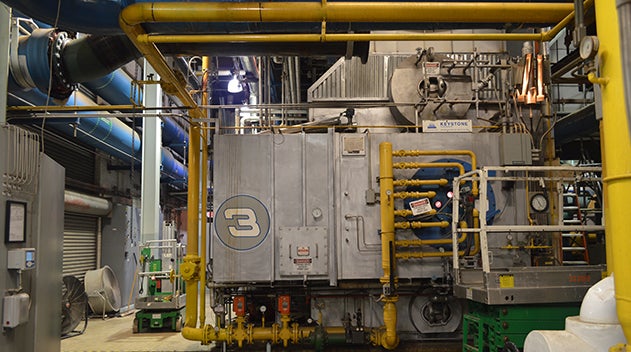Energy Conservation and Efficiency

Georgetown is taking significant steps to cut our energy demand and use energy more efficiently, an important part of our approach to reducing our greenhouse gas emissions .
Since FY14, the university has invested in a set of efficiency measures that are saving at least 3.3 million kWh of electricity and 82,000 MMBtu of natural gas each year – cutting 5,500 metric tons of CO2 or the equivalent of planting over 140,000 new trees.
Explore the links and information below to learn more about our efficiency and conservation work.
Energy Efficiency and Conservation Initiatives
The department of Planning and Facilities Management pursues energy efficiency and conservation opportunities on an ongoing basis. We also have an ongoing collaboration with the District of Columbia Sustainable Energy Utility to achieve mutual sustainable energy goals.
District Heating and Cooling: Georgetown’s Central Utility Plant supplies the Main and Medical Campuses with district heating and cooling to control temperatures in our buildings. By using centralized boilers and chillers, and piping steam and chilled water across the campus, the university is able to achieve significant efficiencies through scale. We continuously explore and pursue opportunities for further efficiency through centralized equipment upgrades.
Retrofits at Central Heating and Cooling Plant: Georgetown’s Office of Utilities and Energy Management regularly upgrades the Central Plant, providing ongoing efficiencies. Most recently as of FY17, projects like the installation of a new efficient chiller, variable frequency drives for water pumps, utility plant LED lighting retrofits and insulation of chilled water pipes are saving energy at the central plant. A 2014 boiler fan upgrade, steam trap repairs and a de-aerator project also cut an estimated annual 2,508 metric tons of CO2e, equal to taking about 528 cars off the road each year.
Building Energy Retrofits: Facilities Management implements building energy retrofits as part of their ongoing operations. Examples of recent energy-efficiency retrofits include:
- LED-retrofits for lighting in buildings are performed on an ongoing basis as of FY17. Projects include a whole-building LED retrofit of White Gravenor, which is expected to save approximately 200,000 kWh of electricity per year, and LED upgrades in Med-Dent, Hoya Court, and other spaces. To date, LED upgrades have been performed for approximately 500,000 square feet of building area.
- In August 2016, Georgetown University completed a retrofit of its Alumni Square residence hall, replacing all of the gas furnaces and air conditioners with more efficient models, and replacing the water heaters in each individual unit with shared, tankless water heaters. As a result of these efficiency upgrades, the University will save nearly $18,000 per year and reduce emissions by 382 tons of CO2 per year, equivalent to the annual emissions of over 36 average homes.
- In FY2014, a multi-building steam trap replacement project is saving about 17,000 mmBtu of natural gas and 902 metric tons of CO2e, equal to taking about 190 cars off the road each year.
- In FY2012, a lighting retrofit in the Southwest Garage is helping cut an estimated 1 million pounds of CO2 annually, the equivalent of taking about 55 US homes off the grid.
Building Energy Audits: In FY14, Georgetown sponsored Level I ASHRAE Energy Audits for over 40 buildings on campus. The audits identified over 400 unique Energy Conservation Measures and are helping inform long-range energy plans for the campus.
Building Automation System: Our energy management team uses a centralized, digital building automation system which allows for the control of temperatures and efficient energy use in campus buildings.
Demand Response: Georgetown participates in regional Demand Response program during hot summer months when energy use peaks. During such events, our utilities team may shut off power to non-critical systems, raise temperature setpoints in unoccupied spaces, and/or take other measures to curtail energy. Combining these central actions with our voluntary energy conservation pledge can save significant amounts of energy, help avoid brownouts, and reduce air pollution.
Commitment to LEED Buildings: GU is committed to obtaining LEED Silver or higher for all new construction and major renovations. The LEED rating system includes a significant emphasis on energy efficiency, helping ensure that our new buildings use energy more efficiently. Read more >>
Engagement and Planning
Behavior-change and Engagement Initiatives: Programs like the Switch It Off Challenge , a student competition to save energy between Residence Halls, and the GU Campus Energy Conservation Program , a voluntary curtailment program to engage faculty and staff, help involve the campus community in reducing energy demand and cutting carbon.
Collaboration and Partnerships: Georgetown works to establish active partnerships and collaborations with campus and community partners such as the District of Columbia Sustainable Energy Utility (DCSEU) in support of our climate and sustainability commitments. Click HERE to read about our recent collaboration with the DCSEU to save energy at the central plant.
Sustainability Planning and Carbon Roadmap: As part of our ongoing 2017 Master Planning initiative , Georgetown is developing an action plan to meet our climate and sustainability commitments.
Click HERE to learn even more about GU’s leadership on energy and climate and our work to cut our carbon footprint.
